I just acquired a Rakuyaki (楽焼) tea bowl. The artist is Koraku (光樂).

It caught my eyes the first second I saw it, and I believed I was looking at a great master piece of a Raku ware, specifically, a Kuro Rakuyaki or 黒楽焼. The seller revealed that this bowl is made 40 years ago. A famous monk named Gensei Miyanishi, the superintendent priest of a Rinzai (臨済) temple, signed the wooden container box and gave the name Ai oi (相生) to this bowl. The meaning of the word Ai oi is rather ambiguous - as it is always for an Eastern mind! One way to render it could be "(the two) living in harmony." However, the Japanese seller gives "wooden root is divided into two truncks"! and therefore, suggests that this teaware is best to be used in Spring season.

Myōan Eisai (明菴栄西), the founder of the Rinzai School of Zen in Japan during 12th century wrote the famous 喫茶養生記 Kissa Yojoki, Treatise on Tea Drinking for Health. That was the oldest tea specialty book in Japan.
A similiar item by the same artist can be found being bid currently on Yahoo Japan (for 15,000円).

(茶道具 黒楽茶碗 光樂造 銘 庵の友 箱書 表 桐共箱)





